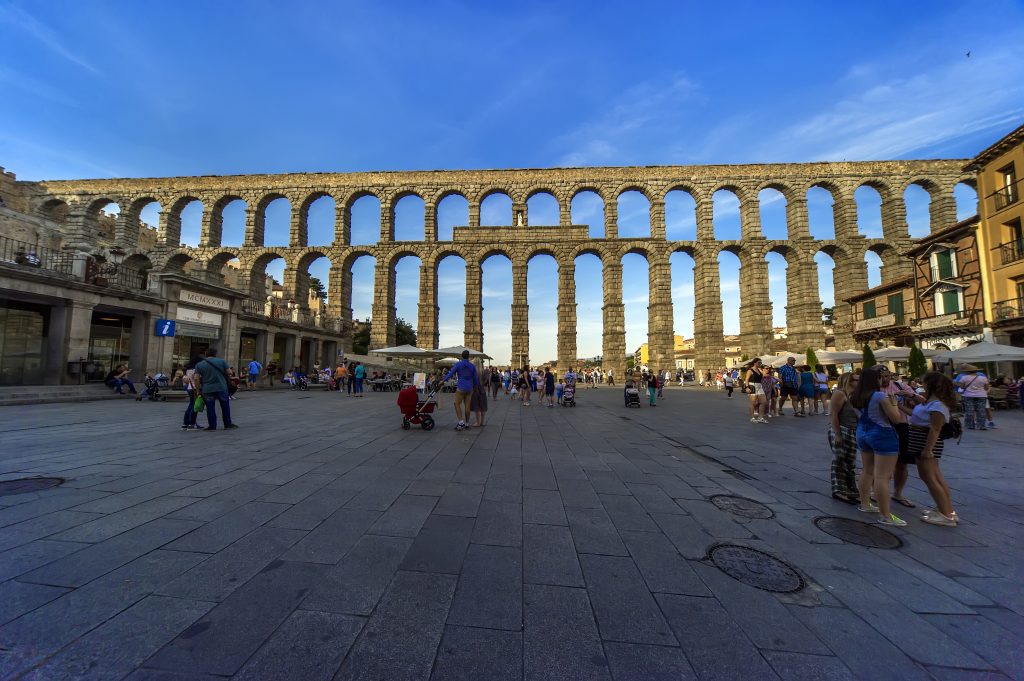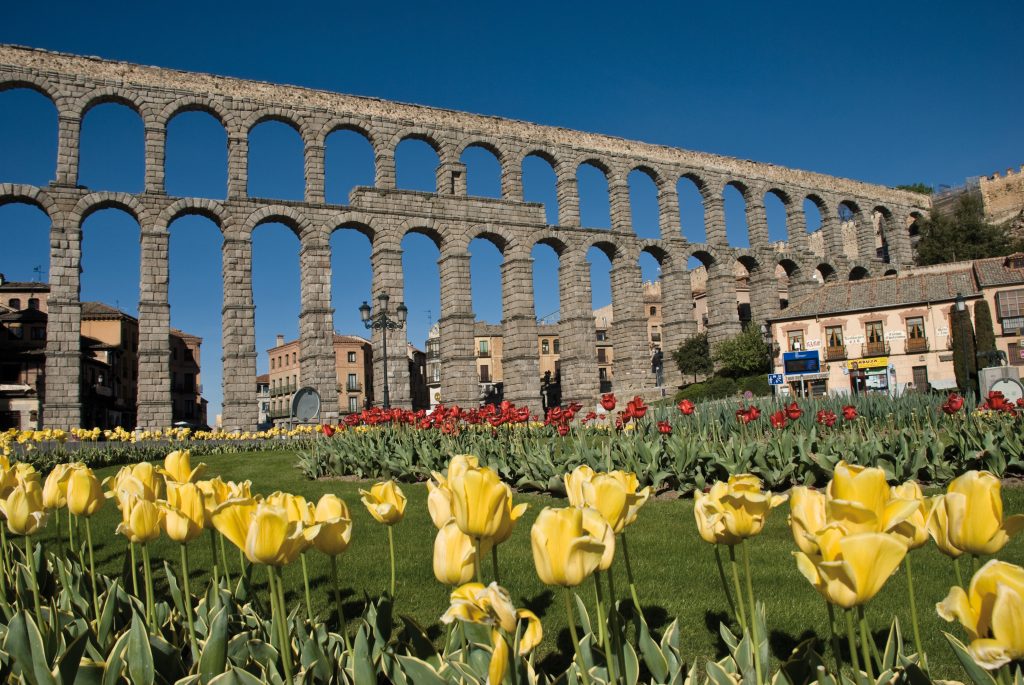 Do you want to read in English? Click here
Do you want to read in English? Click here
 Patrimonio y Turismo: comunidades locales y visitantes: Una responsabilidad compartida
Patrimonio y Turismo: comunidades locales y visitantes: Una responsabilidad compartida
Mi nombre es Ana Martín Quirós, tengo 21 años y soy estudiante de la doble titulación en Publicidad y Relaciones Públicas y Turismo, en el campus María Zambrano (Segovia), de la Universidad de Valladolid. He formado parte del proyecto Jóvenes Embajadores del Patrimonio Mundial, en su cuarta embajada en Aarhus (Dinamarca), promocionando la riqueza patrimonial y cultural de Segovia en esta ciudad. Y es que no solo la Ciudad Vieja, sino también el Acueducto de Segovia fueron incluidos en la lista del Patrimonio Mundial, el 6 diciembre de 1985, por el Comité del Patrimonio Mundial. En 2015 Segovia, además, como miembro de la OCPM y con motivo del 30 aniversario de su declaración como Patrimonio de la Humanidad, se sumó al proyecto Jóvenes Embajadores del Patrimonio Mundial.
Los motivos de su declaración son obvios. El acueducto de Segovia, construido en el siglo I-II, es uno de los símbolos de la ciudad. Es único en el mundo y es el ejemplo más importante de la ingeniería civil romana de España. La parte más visible es la arquería que cruza la plaza del Azoguejo, donde alcanza su mayor altura, 28 metros. Cuenta con un total de 167 arcos que han visto pasar a lo largo de los más de 2000 años que lleva en pie culturas como los celtas, romanos, visigodos, árabes o judíos.
La Catedral de Segovia, conocida como la Dama de las Catedrales por sus dimensiones y elegancia, se construyó entre los siglos XVI y XVIII. Es una de las catedrales góticas más tardías de España y de Europa, contando con impresionantes vidrieras del siglo XVI. Se encuentra ubicada en la Plaza Mayor y recoge el primer libro impreso de este país.
El Alcázar de Segovia es uno de los monumentos más visitados a nivel nacional. Fue una residencia Real y, originalmente, durante el periodo romano, una fortaleza. Parece un barco navegando entre dos ríos: el río Eresma y el Clamores.
Sin embargo, el potencial de Segovia como sitio patrimonio mundial no solo se fundamenta en este recorrido principal. La Calle Real, con sus tiendas, ambiente y la seña de identidad que son los esgrafiados de origen mudéjar en las fachadas segovianas; el barrio medieval de la judería; la estatua de Juan Bravo, héroe local; la iglesia de San Martín; el Torreón de Lozoya; la gastronomía segoviana, famosa por su cochinillo y su ponche segoviano; o el teatro Juan Bravo y el Ayuntamiento, son algunos de los muchos otros ejemplos.
La Real Casa de la Moneda, por su parte, se encuentra cerca del Alcázar y junto al río Eresma. Es un edificio construido en el siglo XVI como sede de la primera casa de moneda mecanizada en España. Está reconocida como uno de los edificios de arquitectura industrial más antiguos de toda Europa.
En honor a Antonio Machado, poeta español de la generación del 98 que se mudó a Segovia entre 1919 y 1932, existe actualmente una ruta que permite seguir sus pasos durante su estancia en Segovia, incluyendo lugares tan emblemáticos como la casa que habitó, cuyas puertas se abrieron dando lugar a la Casa-Museo Antonio Machado. En el interior se puede encontrar su habitación, tan modesta como fue en su momento, con exactamente los mismos muebles. Sin embargo, se han colgado en las paredes a modo de homenaje retratos, óleos, dibujos, recortes de prensa y carteles de artistas locales y personajes de gran renombre como Rafael Peñuelas, Álvaro Delgado, Pablo Picasso o Jesús Unturbe.
El museo de títeres de Segovia recoge la colección de más de 40 títeres que el maestro marionetista Francisco Peralta donó a la ciudad. Estos representan personajes de obras de teatro tomadas del romancero popular. Y es que los títeres en Segovia son bastante importantes. Cada año, la ciudad acoge durante cinco días el Festival Internacional de Teatro de Títeres «Titirimundi». Las calles se llenan de actuaciones y muchísimo ambiente. Este año será la 33ª edición, en mayo. Otro de los festivales que la ciudad recoge es la Muestra de Cine Europeo Ciudad de Segovia (MUCES), certamen cinematográfico de carácter anual que fomenta la difusión y el conocimiento del cine europeo.
Por otra parte, las fiestas patronales dependiendo del santo, San Juan y San Pedro en junio, San Lorenzo en agosto y Fiestas de San Frutos en octubre; o las celebraciones religiosas como la Semana Santa, forman parte también de la actividad cultural de la ciudad.
Podemos encontrar, asimismo, gran número de zonas verdes. Rutas andando alrededor del río Eresma, por la Lastrilla, o incluso una Vía Verde. También zonas no tan verdes como el Puerto de Navacerrada, puerto de montaña de 1858msnm de altitud que alberga una estación de esquí, separando Madrid de la provincia de Segovia.
En definitiva, Segovia, por su cultura e historia, con su Acueducto, la multitud de iglesias románicas, su Catedral y Alcázar, museos, festivales y paisajes naturales, es digna de ser reconocida como sitio Patrimonio Mundial.
Pincha aquí para descargar el fichero PPT / Click here to download PPT file: http://ibiza.young-ambassadors.net/ppts/Segovia.pptx
 Heritage and tourism: local communities and visitors – a shared responsibility
Heritage and tourism: local communities and visitors – a shared responsibility
My name is Ana Martín Quirós, I am 21 years old and I am a student of the double degree in Tourism, Advertising and Public Relations, in the María Zambrano Campus (Segovia, UVa University). I have been part of the project Young Ambassadors of World Heritage, in its fourth embassy in Aarhus (Denmark), promoting the heritage and cultural wealth of Segovia in this city. Not only the Downtown but also the Segovia’s Aqueduct were included in the World Heritage List, the 6th December 1985, by the World Heritage Committee. In 2015 Segovia, as a member of the OCPM and thanks to the 30th anniversary of its declaration as a World Heritage City, it joined the project Young Ambassadors of World Heritage.
The reasons of its declaration are obvious. The Aqueduct of Segovia, built in the I-II century, is one of the icons of the city. It is unique in the world and it is the most relevant example of the Roman civil engineering in Spain. The most visible part is the arcade that crosses the Plaza del Azoguejo, where it reaches its greatest height. It has a total of 167 arches that have been seen by cultures such as the Celts, Romans, Visigoths, Arabs and Jews throughout more than 2000 years.
Segovia’s cathedral, known as the Cathedrals Lady due to its dimensions and elegance, was built between the centuries XVI and XVIII. It is one of the latest gothic cathedrals in Spain and Europe, with impressive stained glass windows from the 16th century. It is located in the Plaza Mayor and it collects the first printed book of this country.
The Alcazar of Segovia is one of the most visited monuments nationwide. It was a Royal residence and, originally, during the Roman period, a fortress. It looks like a ship sailing between two rivers: the Eresma and the Clamores.
However, the potential of Segovia as a world heritage site is not only based on this main route. Some of the many other examples are The Calle Real, with its shops, atmosphere and the sign of identity that the Mudejar sgraffitos in the facades of Segovia are; the medieval Jewish quarter; the statue of Juan Bravo, local hero; the church of San Martín; the Lozoya’s fortified tower; the gastronomy of Segovia, famous for its suckling pig and its Segovian punch; or the Juan Bravo theatre and the City Hall.
The Royal Mint, on the other hand, is near the Alcazar and next to the Eresma River. It is a building built in the 16th century as the seat of the first mechanized coin house in Spain. It is considered as one of the oldest industrial architecture buildings in Europe.
Currently and in honour of Antonio Machado, Spanish poet of the generation of 98 who moved to Segovia between 1919 and 1932, there is a route that allows you to follow his steps during his stay in Segovia, including emblematic places such as the house he lived in, whose doors were opened giving rise to the Antonio Machado House-Museum. His room can be found in the inside, as modest as it was at the time, with exactly the same furniture. However, portraits, oil paintings, drawings, press clippings and posters, of local artists and renowned personalities such as Rafael Peñuelas, Álvaro Delgado, Pablo Picasso and Jesús Unturbe, have been hung on the walls as a tribute.
The puppet museum of Segovia collects the collection of more than 40 puppets that the puppeteer master Francisco Peralta donated to the city. These represent characters from plays taken from the popular ballads. It must be said that puppets in Segovia are quite important. Every year, the city hosts for five days the International Puppet Theater Festival «Titirimundi». The streets are full of performances and people. This year will be the 33rd edition, in May. Another of the festivals that the city hots is the European Film Festival Segovia City (MUCES), an annual film festival that promotes the dissemination and knowledge of European cinema.
On the other hand, the patron saint festivities depending on the saint, San Juan and San Pedro in June, San Lorenzo in August and Fiestas de San Frutos in October; or religious celebrations such as Holy Week, are also part of the cultural activity of the city.
We can also find a large number of green areas. Walking routes around the Eresma River, along the Lastrilla, or even a Greenway. Also other areas such as Puerto de Navacerrada, mountain pass of 1858msnm altitude that houses a ski resort, separating Madrid from the province of Segovia. In short, Segovia, for its culture and history, with its Aqueduct, the multitude of Romanesque churches, its Cathedral and Alcazar, museums, festivals and natural landscapes, is worthy of being recognized as a World Heritage Site.















